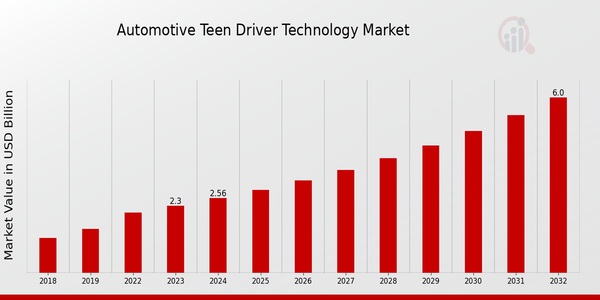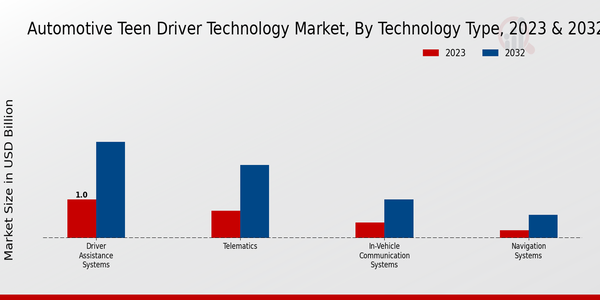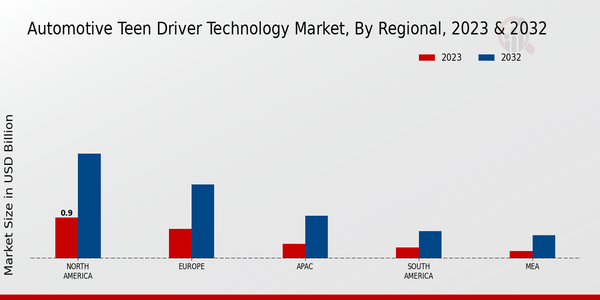Automotive Teen Driver Technology Market Overview
As per MRFR analysis, the Automotive Teen Driver Technology Market Size was estimated at 2.85 (USD Billion) in 2024. The Automotive Teen Driver Technology Market Industry is expected to grow from 3.17 (USD Billion) in 2025 to 8.28 (USD Billion) till 2034, at a CAGR (growth rate) is expected to be around 11.25% during the forecast period (2025 - 2034).
Key Automotive Teen Driver Technology Market Trends Highlighted
The Automotive Teen Driver Technology Market is significantly influenced by key market drivers, such as the rising focus on road safety and the need to reduce accidents among inexperienced drivers. Parents and guardians are increasingly concerned about their teenagers' driving habits, leading to the adoption of technologies that promote safer driving.
These technologies often include features like speed limiters, geo-fencing, and driver monitoring systems, which aim to create a safer driving environment for young drivers. There are various opportunities to be explored in this market, especially as advancements in technology become more widespread.
The integration of smartphones and apps with vehicle systems offers a new avenue to engage teen drivers while providing parents with valuable insights into their driving behavior. Furthermore, partnerships between automotive manufacturers and technology firms can lead to the development of innovative solutions that cater specifically to the needs of teen drivers.
In recent times, trends have emerged that resonate with the enhanced connectivity offered by smart technologies. As vehicles become more connected, the use of real-time data to monitor driver performance is gaining traction. Additionally, gamification elements are being incorporated into driving programs to encourage safe driving behaviors among teens.
The introduction of educational resources tied to these technologies is also creating a culture of responsible driving among young people. Overall, the interplay of these factors is shaping the future of the automotive teen driver technology market, making it a dynamic space for growth and development.

Source: Primary Research, Secondary Research, MRFR Database and Analyst Review
Automotive Teen Driver Technology Market Drivers
Increasing Emphasis on Teen Driver Safety
The Automotive Teen Driver Technology Market is poised for significant growth due to the escalating focus on ensuring the safety of teen drivers. There has been a growing concern among parents, educators, and policymakers about the rising number of accidents involving inexperienced drivers.
This has led to increased advocacy for enhanced driving education and the inclusion of advanced safety technologies in vehicles targeted at this demographic.
Technologies such as automatic emergency braking, lane-keeping assistance, and collision avoidance systems are becoming standard in vehicles, aimed specifically at reducing the risk of accidents among young drivers.
The concerted efforts by automotive manufacturers and government bodies to raise awareness about safe driving practices further bolster this trend. Additionally, a collaboration between technology firms and car manufacturers to develop innovative solutions tailored for teen drivers is paving the way for a plethora of new products in the market.
Coupled with substantial investments in the development of software applications that promote responsible driving habits among teenagers, the market is experiencing robust growth driven by these safety initiatives.
The shift in consumer preferences toward vehicles that offer advanced safety features will continue to significantly influence the Automotive Teen Driver Technology Market in the coming years.
Technological Advancements in Automotive Safety Systems
The rapid technological innovation in automotive safety systems is a prominent driver for the Automotive Teen Driver Technology Market. Continuous advancements in Artificial Intelligence (AI), machine learning, and sensor technologies are enabling the development of features that assist teen drivers in operating vehicles more safely.
Features such as real-time feedback systems, alcohol detection systems, and geo-fencing capabilities are being incorporated into vehicles to enhance driver awareness and restrict dangerous behaviors.
This transformation not only appeals to safety-conscious parents but also integrates seamlessly with the preferences of tech-savvy younger generations. The increasing integration of telematics and mobile applications designed to monitor driving habits contributes to the market's expansion, providing an additional layer of security and control for teen drivers.
Growing Parental Concerns and Involvement
The heightened anxiety among parents regarding their teen drivers is significantly fueling the Automotive Teen Driver Technology Market. As teenagers gain independence behind the wheel, parents are more involved than ever in seeking solutions that enhance their children's safety while driving.
This growing trend of parental engagement has resulted in a greater demand for technology solutions that provide real-time monitoring and alerts concerning driving habits, location, and unsafe behaviors.
Parents increasingly look for vehicles equipped with systems that can help mitigate risks associated with teen driving, such as speeding or distracted driving. Technologies enabling remote access to driving data and the ability to set restrictions on vehicle usage are becoming very appealing to parents, supporting the development of specialized products aimed at this segment of the market.
Automotive Teen Driver Technology Market Segment Insights:
Automotive Teen Driver Technology Market Technology Type Insights
The market's expansion is significant across different technology types, with Driver Assistance Systems holding a majority share, valued at 1.0 USD Billion in 2023, and projected to grow to 2.5 USD Billion by 2032.
This sub-segment played a critical role in preventing accidents and improving the overall driving experience through features like lane-keeping assistance and adaptive cruise control, which are becoming increasingly essential for new drivers.
Following closely, Telematics, valued at 0.7 USD Billion in 2023, was also pivotal, especially in providing real-time tracking and diagnostics, thereby promoting responsible driving behavior among teenagers. It is expected to reach 1.9 USD Billion by 2032, highlighting its rising significance in this market.
Meanwhile, In-Vehicle Communication Systems, with a valuation of 0.4 USD Billion in 2023, served as an essential tool for fostering communication and reducing distractions while driving. This segment is projected to increase to 1.0 USD Billion by 2032, indicating a growing awareness of the importance of connectivity features in vehicle safety.
Lastly, Navigation Systems, starting at 0.2 USD Billion in 2023, although the smallest segment, showed significant potential for growth, with an expected rise to 0.6 USD Billion by 2032. The increasing reliance on accurate navigation aids for new drivers underlines the importance of this technology in promoting safe driving practices.
Collectively, these technology types contribute to the overall market statistics, with strong trends toward integrating smart technologies within vehicles aimed at enhancing safety and driver engagement for teenager drivers.
The insights illustrate a robust market structure focused on improving teen driving competency, with each technology type playing a distinct yet interrelated role in the overarching goal of reducing teen driving incidents.
As the market continues to evolve, innovations in these areas will likely drive significant investment and development, underscoring the sizable opportunities present within the Automotive Teen Driver Technology Market.

Source: Primary Research, Secondary Research, MRFR Database and Analyst Review
Automotive Teen Driver Technology Market Vehicle Type Insights
The market exhibits notable trends, particularly in Passenger Vehicles, which are critical for accommodating new technology due to their widespread usage among teen drivers. SUVs have also captured significant attention, driven by their appeal to families who prioritize safety features for their teenage children.
The Truck segment showcases potential due to increasing interest in guidance systems for teen drivers engaged in commercial activities, while Motorcycles emerge as a niche area with growing awareness regarding rider safety technologies.
The growing emphasis on road safety education and smart driving practices continues to propel innovations within the market. Furthermore, the rise in connected vehicle technology creates opportunities for the optimization of teen driver experiences, enhancing safety and aiding in skill development.
Market growth is also influenced by stricter government regulations and the expansion of awareness campaigns aimed at reducing accidents among teen drivers.
Overall, the Automotive Teen Driver Technology Market data indicates a proactive approach to integrating advanced systems in various vehicle types, with significant emphasis on safety and user education.
Automotive Teen Driver Technology Market Feature Set Insights
The Feature Set segment plays a crucial role in enhancing safety for teen drivers, with prominent areas including Distracted Driving Prevention, Speed Limit Monitoring, Teen Driver Feedback Systems, and Emergency Response Assistance.
These domains contribute significantly to overall market growth, with Distracted Driving Prevention being vital for reducing accidents linked to smartphone use, which has been a growing concern.
Speed Limit Monitoring ensures adherence to traffic laws, promoting safer driving behaviors among young drivers, while Teen Driver Feedback Systems provide real-time coaching, fostering better skills through constructive criticism.
Emergency Response Assistance is essential for ensuring timely help in case of accidents, significantly impacting teen drivers' safety. The overall market growth is further propelled by increasing awareness about road safety and technological advancements aimed at reducing driving risks.
The Automotive Teen Driver Technology Market statistics reflect a promising trajectory, driven by these critical features that cater to the unique challenges faced by young drivers today.
Automotive Teen Driver Technology Market End User Insights
The increase is driven by various end users, including parents, teen drivers, and driving schools, each playing a critical role in the market dynamics.
Parents represent a significant segment, as they are primarily responsible for purchasing driver technology solutions focused on ensuring their children's safety and education on the road. Teen drivers, as direct users of these technologies, benefit from advancements that enhance their driving skills and awareness, thus contributing to market growth.
Moreover, driving schools play a pivotal role by incorporating these technologies into their training programs, showcasing the importance of practical experience paired with innovative technology.
The Automotive Teen Driver Technology Market data reveals that the collective emphasis on safety, skill development, and responsible driving can lead to substantial market growth as they tackle the challenges posed by inexperienced drivers and the need for structured learning environments.
Overall, the market segmentation reflects a concerted effort to improve driving outcomes for all participants, making the landscape increasingly favorable for advancements and investments.
Automotive Teen Driver Technology Market Regional Insights
The Automotive Teen Driver Technology Market is structured into regional segments, showcasing varied growth patterns across regions. In 2023, North America led the market with a valuation of 0.904 USD Billion, expected to reach 2.314 USD Billion by 2032, highlighting its majority holding in the revenue share.
Europe followed with a valuation of 0.657 USD Billion in 2023, projected to grow to 1.629 USD Billion by 2032, indicating significant investment in teen driver safety technologies. The APAC region, valued at 0.329 USD Billion in 2023, is projected to reach 0.943 USD Billion by 2032, reflecting the increasing adoption of technological advancements in automotive systems.
South America and MEA were comparatively smaller segments, valued at 0.246 USD Billion and 0.164 USD Billion, respectively, in 2023, with projections of 0.6 USD Billion and 0.514 USD Billion by 2032. These figures indicate a growing awareness of teen driving safety in these regions despite their lower market share.
The overall market growth is driven by technological innovations and heightened regulatory emphasis on teen driver safety, presenting opportunities for expansion, particularly in North America and Europe, where there is a strong inclination toward integrating advanced driver-assistance systems for younger drivers.

Source: Primary Research, Secondary Research, MRFR Database and Analyst Review
Automotive Teen Driver Technology Market Key Players and Competitive Insights:
The Automotive Teen Driver Technology Market is a rapidly evolving segment within the automotive industry, characterized by the increasing focus on safety and educational features designed specifically for young and inexperienced drivers.
This market encompasses various technologies aimed at minimizing risks associated with teen driving, such as advanced driver assistance systems, tracking and monitoring solutions, and mobile applications that promote responsible driving behaviors.
The competitive landscape is shaped by several key players who are innovating and investing in technological advancements to capture a greater market share and address the growing demand for protective measures around teen drivers.
Stakeholders in the market are working diligently to establish partnerships and collaborations, enhancing their product offerings while also complying with legislative changes that prioritize road safety for younger demographics.
Toyota has established a solid presence in the Automotive Teen Driver Technology Market by leveraging its commitment to safety through its innovative features and advanced technologies. The company focuses on integrating systems that promote safe driving habits and provide real-time feedback to teen drivers.
With a strong reputation for reliability and safety, Toyota emphasizes educational programs and in-vehicle technologies designed to equip novice drivers with the skills they need to navigate the challenges of the road.
The company’s commitment extends to developing smartphone applications that allow parents to monitor driving behavior, thereby fostering a safe learning environment for teens. By continually investing in research and development, Toyota seeks to enhance its offerings in this niche market, reinforcing its leadership position in safety-conscious innovations.
General Motors is also a significant player in the Automotive Teen Driver Technology Market, focusing on the integration of cutting-edge technologies aimed at enhancing the safety of young drivers. The company implements various features designed specifically for teen-focused vehicles, such as speed limiters and curfews, which are crucial in helping young drivers develop safer habits.
General Motors is known for its comprehensive approach, combining both in-car and smartphone-based solutions to monitor and assess driving behaviors effectively. This multifaceted strategy not only engages teen drivers but also resonates with parents concerned about their children's safety on the road.
With a solid commitment to innovation, General Motors continues to evolve its offerings, ensuring that its vehicles are equipped with the latest technologies that promote safe driving among teenagers, thereby solidifying its position in this competitive market.
Key Companies in the Automotive Teen Driver Technology Market Include:
- Toyota
- General Motors
- Volkswagen
- Hyundai
- Daimler
- Apple
- Ford
- Nissan
- Tesla
- Amazon
- Honda
- Google
- BMW
- Cisco
Automotive Teen Driver Technology Market Developments
Recent developments in the Automotive Teen Driver Technology Market indicate heightened investment and innovation aimed at enhancing safety and education for novice drivers. Companies such as Toyota, General Motors, and Ford are increasingly focusing on incorporating advanced safety features and driver assistance technologies designed specifically for teen drivers.
These features often include geofencing, speed monitoring, and real-time feedback mechanisms. Additionally, firms like Apple and Google are advancing their in-car software to better support educational tools through mobile applications targeting parents and teens.
Current affairs reveal growing partnerships and collaborations among major automotive players and tech companies to enhance teen driver safety. For instance, Volkswagen and Daimler are reportedly exploring new joint ventures focused on integrating connected vehicle technology.
Furthermore, notable growth in market valuation is observed as companies invest in research and development, further driving industry growth. Mergers and acquisitions, while limited, may arise as market leaders seek to consolidate their technologies and expand product offerings to address this crucial demographic.
The increasing recognition of the importance of teen driver safety is shaping policies and technological advancements across the automotive sector, making it a pivotal area of focus for these companies.
Automotive Teen Driver Technology Market Segmentation Insights
Automotive Teen Driver Technology Market Technology Type Outlook
- Driver Assistance Systems
- Telematics
- In-Vehicle Communication Systems
- Navigation Systems
Automotive Teen Driver Technology Market Vehicle Type Outlook
- Passenger Vehicles
- SUVs
- Trucks
- Motorcycles
Automotive Teen Driver Technology Market Feature Set Outlook
- Distracted Driving Prevention
- Speed Limit Monitoring
- Teen Driver Feedback Systems
- Emergency Response Assistance
Automotive Teen Driver Technology Market End User Outlook
- Parents
- Teen Drivers
- Driving Schools
Automotive Teen Driver Technology Market Regional Outlook
- North America
- Europe
- South America
- Asia Pacific
- Middle East and Africa
| Report Attribute/Metric |
Details |
|
Market Size 2024
|
2.85 (USD Billion)
|
|
Market Size 2025
|
3.17 (USD Billion)
|
|
Market Size 2034
|
8.28 (USD Billion)
|
|
Compound Annual Growth Rate (CAGR)
|
11.25% (2025 - 2034)
|
|
Report Coverage
|
Revenue Forecast, Competitive Landscape, Growth Factors, and Trends
|
|
Base Year
|
2024
|
|
Market Forecast Period
|
2025 - 2034
|
|
Historical Data
|
2019 - 2023
|
| Market Forecast Units |
USD Billion |
| Key Companies Profiled |
Toyota, General Motors, Volkswagen, Hyundai, Daimler, Apple, Ford, Nissan, Tesla, Amazon, Honda, Google, BMW, Cisco |
| Segments Covered |
Technology Type, Vehicle Type, Feature Set, End User, Regional |
| Key Market Opportunities |
Increased demand for safety features, Integration with mobile applications, Growing parental control solutions, Advancements in driver monitoring systems, Enhanced user experience through gamification |
| Key Market Dynamics |
increased safety concerns, technological advancements, rising insurance premiums, government regulations, evolving consumer preferences |
| Countries Covered |
North America, Europe, APAC, South America, MEA |
Frequently Asked Questions (FAQ) :
The Automotive Teen Driver Technology Market is expected to be valued at 8.28 USD Billion in 2034.
The market is expected to grow at a CAGR of 11.25% from 2025 to 2034.
North America is projected to dominate the market, with a value of 2.314 USD Billion in 2032.
In 2034, the market value of Driver Assistance Systems is expected to reach 2.5 USD Billion.
The market size for Telematics is expected to be 1.9 USD Billion in 2032.
Major players in the market include Toyota, General Motors, Volkswagen, Hyundai, and Ford.
The market value of Navigation Systems is expected to increase to 0.6 USD Billion in 2032.
In 2023, the market was valued at 0.904 USD Billion in North America.
The In-Vehicle Communication Systems segment is anticipated to grow to a market size of 1.0 USD Billion by 2032.
The projected market size for South America in 2032 is expected to reach 0.6 USD Billion.

















